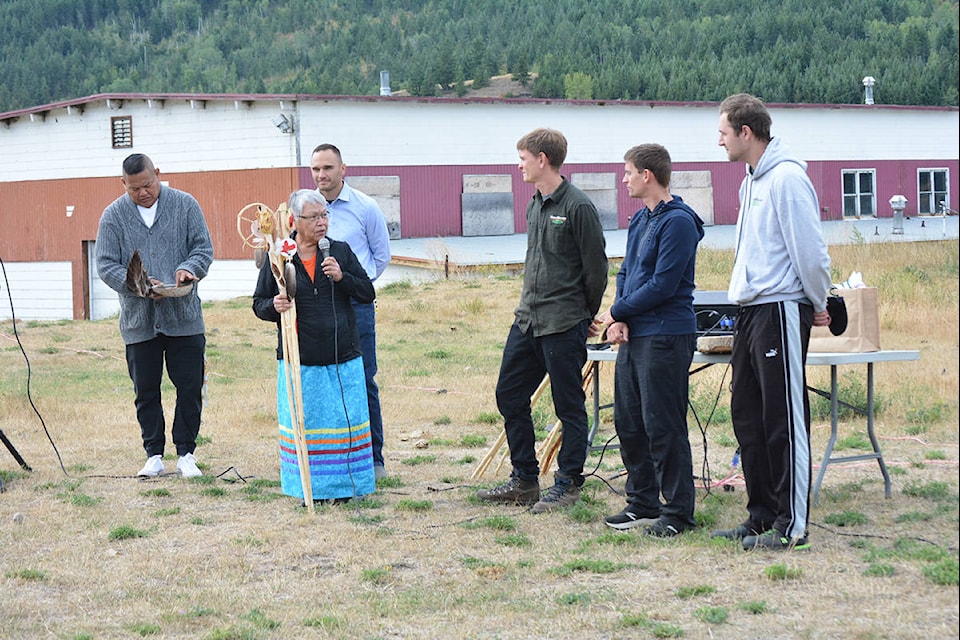Around 50 people attended a ceremony held at the former St. Joseph’s Mission Residential School near Williams Lake Monday, Aug. 30, to mark the beginning of a preliminary investigation of the grounds.
After the Tk’emlups te Secwepemc announced in May 2021 there were 215 unmarked burial sites of children at the former Kamloops Indian Residential School, Williams Lake First Nation (WLFN) confirmed it would also be doing an investigation at the former St. Joseph’s site.
READ MORE: Indigenous communities rocked by Kamloops residential school burial discovery
“The 215 that were found at Tk’emlups to Secwepemc and the reawakening of Indian country across the world and across Canada in each and every province is something that we need to take very seriously,” said WLFN Chief Willie Sellars during the ceremony. “The role of residential schools in this country was to strip the Indian from the child. They were almost successful in doing that. We are starting to get our ceremony back, we are starting to get our culture back in each of our First Nations communities, but there is still a lot of work to do.”
Tk’emlups te Secwepemc Kukpi7 Roseanne Casimir said she was honoured and happy to attend the ceremony.
Since the announcement from her community of the unmarked burial sites, she said her duty as chief has expanded to include the caretakership of those lost children ensuring they are loved, honoured and respected as the community moves forward step by step and working with all the communities collectively that had children taken.
“We are grieving their lives as well as reflecting on our own family stories,” Casimir said. “So many of our home communities across Canada that have had findings of unmarked graves, they too are in our prayers.”
Monday’s ceremony coincided with the commencement of work at the site by GeoScan, a Vancouver-based company, whose technicians will be using a ground-penetrating radar and a magnetometer to investigate 150,000 square metres that encompass historic buildings and barns that are still standing, the school’s footprint and a cemetery.
The project will take about 35 days.
Sellars thanked the present-day property owners for co-operating with the investigation and allowing access to different areas.
“We couldn’t get this work done without you and will be forever thankful. One of the cool comments that the families shared with me even leading up to today was that ‘we are owners of this land, but we are only stewards of this land.’ For a non-Indigenous person to say that, it did mean a lot.”
He said the comments put the elders and leadership at ease that the investigation work could get done.
A larger investigation is planned to encompass a 460-hectare area that will involve working with CN Rail and total of 50 property owners throughout the valley, Sellars added.
Casimir said many groups have been walking, biking, rallying in solidarity with her community.
“All these ceremonies gave hope and inspiration. I stand here strong because of the strong support both I and our community have received since May 27,” she said.
St. Joseph’s Mission was established in 1867 by Roman Catholic Oblate missionaries in an area just south of the current WLFN community of Sugar Cane.
In 1886, St. Joseph’s became an Indian Residential School and remained one until it was closed in 1981.
Whitney Spearing, WLFN rights and title manager, said to date Sugar Cane Archaeology has completed mapping of the structures and footprint of where it is known buildings used to be when the mission was operating.
Most of the 460,000-hectare area for the larger investigation has been photographed by a drone and some fixed wing Lidar scanning has occurred, which will be followed up with more Lidar scanning done by walking on the ground.
“Our archival research is ongoing and massive,” Spearing added.
In July, the WLFN announced an email had been established for people to provide information relevant to the investigation at St. Joseph’s mission, however, most people have chosen to telephone, text, message through Facebook or visit in person.
While the email sjmission@wlfn.ca is still valid, Spearing said if that isn’t hitting people’s needs they can text, phone or walk right into the office.
“We have people to help and set them up with supports and whatever they need.”
There were former St. Joseph’s students travelling from other parts of the province for the ceremony who were going to be doing interviews during the week about specific areas at the site that should be targeted with the ground penetrating radar, Spearing said.
READ MORE: Walk from site of former St. Joseph’s Residential School to Esk’etemc a healing journey
news@wltribune.com
Like us on Facebook and follow us on Twitter
